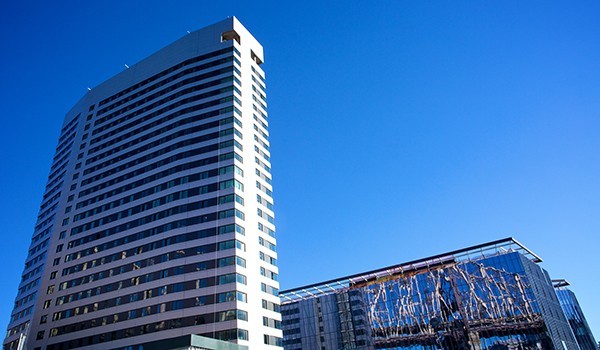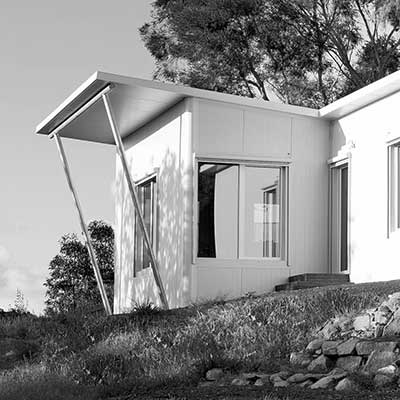 Cornell Tech Certified Passive House building in New York - the largest such high rise in the world
Cornell Tech Certified Passive House building in New York - the largest such high rise in the world
Australian high rise buildings are inefficient. They do not run efficiently. They are not comfortable enough. They waste energy. They contribute to climate change. Failure to use triple glazed windows, and excessive reliance on cheap glazing, are a big part of the problem.
The latest, state-of-the-art high rise office buildings I have visited, get too hot and too cold. In one room you try to work, stifling in the Western sun. There’s no relief except for airconditioning, which is too cold and too erratic. The next room is cold as it faces South. You are uncomfortable standing or sitting next to the glass in either room for much of the year.
A key reason for all of these problems is the amount of poor glazing on our high rise facades. It’s excessive. It’s wasteful. It makes little sense.
But it’s cheap.
Perhaps the designers will tell you that people want it, and the builders will tell you that people will want it.
But do people really want all that discomfort?
It’s doubtful.
Do people really think pure glass facades are so beautiful?
It’s not likely that people are so wedded to how the building looks from the outside as they stand on the street looking up to the 20th floor. How often do they look up to the full height of the façade from the ground down below?
In any event, is glass so beautiful? Is it that much more beautiful than solid materials?
More important than a perception of aesthetic beauty from a vantage point nobody will ever use, is the true beauty of living well in a space, and the beauty that comes from designing well for human occupation. If we redefined beauty in this way, (ie good design), would we allow our building codes to enable such inefficient buildings?
Compare our high rise buildings with the Cornell Tech Building in New York. This 26 storey 350 unit residential building on Roosevelt Island on the East River, is the largest Passive House-certified structure in the world.
And it was built to a tight budget.
Projects like this are inspirational. With a fast-built wall panel system, making airtightness simpler (similar to the concept we have devised for our passive house facades under the Superpod® banner), the building has a modernist appearance, with white solid bands around the glass. The glass is not floor to ceiling, but is enough to enable spectacular views for the occupants.
The glazing makes up only 23% of the beautiful façade. Mind you, it is triple glazed. Proper design. Get better quality and get less of it.
And the beauty of this building is not merely aesthetic. It is “deeply” designed, with great attention to materials and details that you will never see.
Of course, part of the attention to detail is the actual quality of window. The glazing is not cheap single glazing in a certified passive house building. Rather, it will be triple glazing, or sometimes double glazing, with very thermally efficient frames.
All this is done to achieve a beautiful living environment, with comfortable temperatures, fresh air, and a power consumption a mere fraction of what is standard in Western countries.
One of the consultants on the New York Cornell project, Lois Arena, mechanical engineer, has been a key member of the team. I was fortunate to meet her and hear her speak at the New York Passive House High Rise Symposium in New York a couple of years ago. It is clear that it takes dedicated, committed leaders like Lois to achieve a certified passive house of any size, let alone the largest one in the world.
And the true beauty of Cornell would not have been possible if a key member of the design team had insisted on a fully glazed building.
Similarly, the architects’ involvement and support was integral as it is in any passive house project. An interview of Blake Middleton, architect, published by “the Architects Newspaper” on 3 April 2017, reports that while the client was enthused about Passive House after a trip to Europe, the development team were initially unsure if they could achieve the Passive House Standard. Blake said: “Once deeper into the research and design process, and more familiar with what was required, all involved became more confident we could make this work. Everyone stepped up to commit to the effort.”
We can do better in Australia.
The high rise buildings I have occupied or visited in Melbourne in recent years have been unacceptable. When you work in an office, you don’t think about how the façade looks from the ground. You think about how cold you are when the sun goes down and the warmth in the room is sucked out of the glass. You think about how hot you are when the westerly afternoon sun shines through all that glass unabated.
And during those times, when you ask the building manager to adjust the aircon, or you put back on your suit jacket, or you wish you could be wearing a t-shirt – do you really think about the fantastic views from all that floor to ceiling glass all around the building?
Again, part of the problem is the poor quality of our glazing in this country. We should at the very least be using double or triple glazed windows using the most effective commercial glazing tools to bring a more comfortable living environment into our buildings.
The Passive House Standard is relevant in Australia, and every time you feel discomfort in your building, remember that the designers could have done better. And our building codes could be impr
Australian high rise buildings are inefficient. They do not run efficiently. They are not comfortable enough. They waste energy. They contribute to climate change.
The latest, state-of-the-art high rise office buildings I have visited, get too hot and too cold. In one room you try to work, stifling in the Western sun. There’s no relief except for airconditioning, which is too cold and too erratic. The next room is cold as it faces South. You are uncomfortable standing or sitting next to the glass in either room for much of the year.
A key reason for all of these problems is the amount of glazing on our high rise facades. It’s excessive. It’s wasteful. It makes little sense.
But it’s cheap.
Perhaps the designers will tell you that people want it, and the builders will tell you that people will want it.
But do people really want all that discomfort?
It’s doubtful.
Do people really think pure glass facades are so beautiful?
It’s not likely that people are so wedded to how the building looks from the outside as they stand on the street looking up to the 20th floor. How often do they look up to the full height of the façade from the ground down below?
In any event, is glass so beautiful? Is it that much more beautiful than solid materials?
More important that a perception of aesthetic beauty from a vantage point nobody will ever use, is the true beauty of living well in a space, and the beauty that comes from designing well for human occupation. If we redefined beauty in this way, (ie good design), would we allow our building codes to enable such inefficient buildings?
Compare our high rise buildings with the Cornell Tech Building in New York. This 26 storey 350 unit residential building on Roosevelt Island on the East River, is the largest Passive House-certified structure in the world. Wow. http://thehouseatcornelltech.com/sustainability/
And it was built to a tight budget.
Projects like this are inspirational. With a fast-built wall panel system, making airtightness simpler (similar to the concept we have devised for our passive house facades under the Superpod® banner), the building has a modernist appearance, with white solid bands around the glass. The glass is not floor to ceiling, but is enough to enable spectacular views for the occupants.
The glazing makes up only 23% of the beautiful façade.
Not 40%, not 70%, not fully glazed.
And I think it’s a beautiful looking building.
But the beauty of this building is not merely aesthetic. It is “deeply” designed, with great attention to materials and details that you will never see.
Of course, part of the attention to detail is the actual quality of window. The glazing is not cheap single glazing in a certified passive house building. Rather, it will be triple glazing, or sometimes double glazing, with very thermally efficient frames.
All this is done to achieve a beautiful living environment, with comfortable temperatures, fresh air, and a power consumption a mere fraction of what is standard in Western countries.
One of the consultants on the New York Cornell project, Lois Arena, mechanical engineer, has been a key member of the team. I was fortunate to meet her and hear her speak at the New York Passive House High Rise Symposium in New York a couple of years ago. It is clear that it takes dedicated, committed leaders like Lois to achieve a certified passive house of any size, let alone the largest one in the world.
And the true beauty of Cornell would not have been possible if a key member of the design team had insisted on a fully glazed building.
Similarly, the architects’ involvement and support was integral as it is in any passive house project. An interview of Blake Middleton, architect, published by “the Architects Newspaper” on 3 April 2017, reports that while the client was enthused about Passive House after a trip to Europe, the development team were initially unsure if they could achieve the Passive House Standard. Blake said: “Once deeper into the research and design process, and more familiar with what was required, all involved became more confident we could make this work. Everyone stepped up to commit to the effort.”
We can do better in Australia.
The high rise buildings I have occupied or visited in Melbourne in recent years have been unacceptable. When you work in an office, you don’t think about how the façade looks from the ground. You think about how cold you are when the sun goes down and the warmth in the room is sucked out of the glass. You think about how hot you are when the westerly afternoon sun shines through all that glass unabated.
And during those times, when you ask the building manager to adjust the aircon, or you put back on your suit jacket, or you wish you could be wearing a t-shirt – do you really think about the fantastic views from all that floor to ceiling glass all around the building?
Again, part of the problem is the poor quality of our glazing in this country. We should at the very least be using double or triple glazed windows to bring a more comfortable living environment into our buildings.
The Passive House Standard is relevant in Australia, and every time you feel discomfort in your building, remember that the designers could have done better. And our building codes could be improved. And we could all step up to commit to a better Standard.
Not just aspirational components here and there. Not just passive house principles. But true blue, properly designed and constructed certified Passive House Standard buildings.
We need to let go of our obsession with architectural renders of high rise buildings covered in cheap, shiny glass.
Designing properly, to achieve the energy-efficiency and comfort of the Passive House Standard is possible. And it’s relevant. And it’s what true beauty in buildings should really be about.
When you’ve experienced a passive house building in any of our Australian climates, as I’ve had the privilege to do in a Superpod® podhouse®, you know it’s both relevant and possible in this country.
As it is in Frankfurt, and London, and New York.





